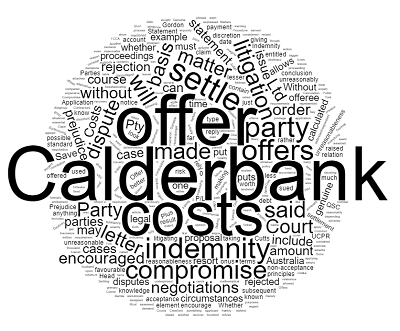Table of Contents
Toggle Calderbank Offers are genuine offers made by a party in litigation to settle a dispute.
Calderbank Offers are genuine offers made by a party in litigation to settle a dispute.
Calderbank offers are so called because of the case which gives them their name Calderbank v Calderbank [1975] 3 All ER 333.
Parties to a dispute (debt dispute for example) are encouraged to compromise and settle their dispute rather than taking up the Courts time with expensive litigation.
There are a number of alternative dispute resolution methods depending on the type of matter you have, they include mediation, conciliation, arbitration, expert determination, and in most cases by negotiation.
The making of offers to settle the matter, either under the Uniform Civil Procedure Rules 1999 (QLD) (“UCPR”) or under the cover of without prejudice negotiations is an essential part of the litigation process.
Our Queensland litigation lawyers explain all you need to know about the Calderbank offers to settle, try to explain the Calderbank offer costs consequences, give a Calderbank offer definition, and the wording of Calderbank offers.
If you have a commercial dispute and you want to end it with the least amount of stress and legal costs, you should engage a legal professional to negotiate on a without prejudice basis and draft Calderbank offers
What is a Calderbank Offer?
A Calderbank offer is a type of offer that can be made by a party looking to resolve a dispute that they are involved in.
Taking a dispute to trial is generally something to be avoided if it can be helped. A trial is a long, expensive process that will usually end with a winning and losing party, rather than both walking away with a resolution that is in some way beneficial.
For this reason, it is common for parties to look for alternative routes for resolving their matter, one of which may be a Calderbank offer.
It encourages parties to engage in negotiation rather than going to trial with the dispute so that they can both benefit from the arrangement.
It is made by one party to another. In order for it to be valid, it must be a genuine offer that the other party has a reasonable period to consider.
A defining feature of a Calderbank offer is that it is made “without prejudice save as to costs”, which will be explained later in the article!
A benefit of a Calderbank offers to the party making it is that it may provide them with cost protections if the receiving party chooses to reject it and fails to obtain a better outcome in trial.
If such is the case, the receiving party, or the offeree, may be required to pay part of the offeror’s costs.
This is because it will be considered unreasonable for the offeree to have rejected the offer in the first place and brought the dispute to trial.
What are the Essential Elements of a Calderbank Offer?
Now that we have discussed the meaning and purpose of a Calderbank offer, it is time to discuss the essential elements.
A Calderbank offer is an important offer to make, and you should be sure to do it correctly to reap the benefits. Some of the key elements of a Calderbank offer include:
- A statement about application for indemnity costs.
- A statement about cost calculation.
- Clearly state terms of the offer to settle.
- Genuine offer of compromise.
- It must contain sufficient information.
- Must say it is a Calderbank v Calderbank offer.
- Set a time for the offer to be accepted.
- It must say without prejudice save as to costs.
We will explain these in more detail below.
Without Prejudice Save as to Costs
One of the first requirements of any settlement negotiations is the requirement of the phrase “Without Prejudice Save as to Costs”.
Without prejudice – is a privilege which attaches to settlement negotiations. The primary reason is to encourage parties to settle their dispute without the matters raised in these negotiations being used against them, or to their prejudice in the course of proceedings.
In Cutts v Head [1984] 1 All ER 597 Fox LJ said:
Parties should be encouraged so far as possible to settle their disputes without resort to litigation and should not be discouraged by the knowledge that anything that is said in the course of such negotiations (and that includes, of course, as much the failure to reply to an offer as an actual reply) may be used to their prejudice in the course of the proceedings. They should … be encouraged freely and frankly to put their cards on the table.
Save as to costs – allows the issue of the offer, and subsequent non-acceptance of the offer by the other party, to be raised at the conclusion of the proceedings on the issue of legal costs.
The idea is that if Party A makes an offer, which is not accepted by Party B, and Party A is awarded more than the amount of the offer, Party B would have been in a better position had they taken the offer and so Party A can rely on the offer and the non-acceptance by Party B on the issue of the costs of litigating past that point.
Must Say it is a Calderbank v Calderbank Offer
Another element of a Calderbank offer is that the letter must state that it is a Calderbank offer.
This puts the other party on notice as to exactly what type of offer this is, and that it will likely be relied on in the issue of costs if the offer is rejected.
In the recent case of Gordon & Gordon [2017] FCCA 2899 Judge Wilson said:
Importantly for present purposes, that letter contained a statement indicating that the proposal was put under principles well-known following the decisions in Calderbank and Cutts v Head. By expressing the proposal on the basis that it was underpinned by those cases, from that date the proposal put the husband at risk of an adverse costs order being made against him.
Usually, a Calderbank letter will include a sentence to the effect of:
This offer is made in accordance with the principles expressed in Calderbank v Calderbank [1975] 3 All ER 333
Genuine Offer of Compromise
Another essential element that you should be sure to include in a Calderbank offer is a compelling offer. You should always make your case!
It is important that you put some time and effort into making your offer so that the other party will be compelled to accept.
You will need to make your offer less than if you were to go to court and win.
Say, for example, you predict or are advised that you will win approximately $80,000 if you were to win in court.
You should make your offer less than $80,000, but enough that it still benefits you!
No one will be willing to accept an offer if they would pay the same if they went to court!
This can be difficult to fulfil in some matters, as you can’t always predict what the court will decide, so potentially seek legal advice or research similar matters.
The offer must be a genuine offer of compromise. A compromise has been defined as the giving away of something.
In Cape York Airlines Pty Ltd v QBE Insurance (Australia) Ltd (No 2) [2010] QSC 365 Daubney J said:
It is necessary to look at the substance of what is offered in the circumstances of the case to see whether the offer is in truth a compromise. The decision in this regard is one to be made by reference to all the circumstances of the case, not by applying a fixed mathematical formula.
So, for example a compromise for $50,000.00 in a claim worth over $10 million, may not be seen in the same way as an offer of $50,000.00 in a claim worth several hundred thousand.
The offer must be genuine. In Tickell v Trifleska Pty Ltd (1991) 25 NSWLR 353. Rogers CJ Comm D said:
Whether in the totality of the circumstances, the offer by the plaintiff represented any element of compromise or whether it was merely, yet another, formally stated demand for payment designed simply to trigger the entitlement to payment of costs on an indemnity basis.
A Statement about Cost Calculation
A Calderbank offer should contain a statement about the offeror’s legal costs. For example, the letter will contain the $$$ amount of the offer, then a statement about how costs are to be calculated.
This can include:
- Plus costs calculated on the standard basis; or
- Plus costs to be assessed if not agreed; or
- Each party will bear their own costs; and so on.
A Statement about Application for Indemnity Costs
In the Calderbank letter there should also be a statement warning the other party that the offeror intends to apply for indemnity costs if the offer is unreasonably rejected.
This foreshadowing of indemnity costs puts the other party on notice, and when tendered to the Court allows the Court to know that the risk of this order was fully known by the other party.
In Danidale Pty Ltd (t/as Bernie Cornfoot & Sons Earthmoving) v Abigroup Contractors Pty Ltd [2007] VSC 552 Habersberger J said:
Failing to warn the offeree that indemnity costs would be sought if it went ahead and sued and obtained a less favourable result is one matter to take into account in deciding whether the rejection of the offers was unreasonable … In my opinion, the offeree could have reasonably considered, at the date of the offer, that there was some prospect of it being found to be entitled to be paid more … if it sued.
It Must Contain Sufficient Information
Another essential element that you should be sure to include in a Calderbank offer is sufficient information for the other party to consider.
A Calderbank offer can have very high stakes and it is important that it is considered in great detail.
The party’s choice to accept or turn down the offer can have serious effects on their finances and the costs that they will have to pay, as well as the outcome of the matter for all, so they should consider this choice in depth.
Without sufficient information, the party will not be able to make an informed decision about what it is that they are agreeing to, so ensure you explain the offer in great detail and with facts relevant to the proceeding.
Set a Time for the Offer to be Accepted
Another essential element that you should be sure to include in a Calderbank offer is a time-period.
As we discussed previously, there are seriously high stakes involved in a Calderbank offer and whether or not you will accept it.
Not only this, but people have busy lives and schedules, and chances are they will have to fulfil responsibilities outside the dispute in question.
This being said it is the choice of the offeror how long they will have to consider before making a decision.
It is recommended that you provide the other party with 7-14 days to consider before choosing to accept or deny.
This is so they will have sufficient time to consider and consult a lawyer if they wish.
Clearly State Terms of the Offer to Settle
Another essential element that you should be sure to include in a Calderbank offer is clearly stated terms of the agreement.
This essential is similar to the second on this list but is important and should be mentioned regardless.
When you create your Calderbank offer, you should be sure to state the terms of the agreement in a way that is easily understood and visible when reading.
Try to use relatively simple terminology and steer away from jargon that the other party may not understand!
You should also create a clear list of terms that can be easily found and be willing to discuss these terms if necessary.
The Application for Indemnity Costs
If a party has served a Calderbank letter, which was unreasonably rejected by the other party, and then they then get an order not less favourable than the offer, then they can rely on the making of the offer, and its subsequent rejection, in an application for indemnity costs.
Unlike rule 360 of the UCPR which puts the onus on the defendant/respondent to show why an order for indemnity costs should not be made, the onus in relation to Calderbank offers is on the applicant to argue why an order for indemnity costs should be made.
Whether the Court awards costs on the indemnity basis is at the discretion of the Court. The unreasonable rejection of a reasonable Calderbank offer of compromise is just one of the factors that the Court will consider.
In relation to the Calderbank offer (or offers) and the exercise of its discretion, some of the issues that the Court will look at include:
- The reasonableness of the offer and the extent of the compromise;
- The unreasonableness of the rejection of the offer;
- When the offer was made, and the facts known to the offeree at the time;
- The reasonableness of the time allowed for acceptance of the offer; and
- The certainty of the terms of the offer.
The Public Interest in Settling Matters Early
As previously mentioned, parties should be encouraged to settle their disputes without resort to litigation.
In Transit Australia P/L v Crewford Australia P/L [1997] QSC 141 Thomas J said:
The public policy behind taking account of such offers is that parties should be encouraged so far as possible to settle their disputes without resort to litigation and that it is hard to imagine anything more calculated to encourage obstinacy and unreasonableness than the comfortable knowledge that a litigant can refuse with impunity whatever may be offered to him even if it as much or more than everything to which he is entitled in the action.
Even though it may not seem like a win in some cases, the offer of a lesser amount, or the acceptance of a lesser amount, is in most cases a good result in commercial debt recovery actions, compared with the costs of litigating the matter to conclusion.
What to Include in a Calderbank Offer?
It is always best to be thorough! Although not entirely essential, you should, where possible, try to include:
- The date that you sent out the correspondence somewhere in the letter;
- Directly state that you will depend on the other party for indemnity costs;
- Keep the Calderbank offer in terms of monetary value and no other act.
- Do not include legal costs;
- Make offers as often as feasible throughout the proceedings to make your case more effective;
- Mention the case that a Calderbank offer is based on, being Calderbank v Calderbank [1975] 3 All ER 333.
- Try to only include one plaintiff on each Calderbank offer, unless they are not disadvantaged or dissuaded from accepting the offer due to the presence of other plaintiffs and this can be proven to be true;
- If you believe that there is a reasonable chance that you will lose part of the case, make provisions for this possibility on the offer;
- Make an allowance for interest if it is reasonable/safe for you to do so.
Should I Accept a Calderbank Offer?
What if I am on the other end of a Calderbank offer and am deciding on whether or not I should accept?
This can be a difficult decision, as the stakes are quite high, so it is important that you properly consider it.
It can be helpful to have a list of key considerations to be made to base your decision to accept on!
Will I Win?
The first thing that you should consider if you receive a Calderbank offer is whether or not you think you will win. If you think that you will win the matter, you may choose not to accept the Calderbank offer as you can probably get a far better outcome if you win in court.
If you think that there is a reasonable chance that you will lose, it may be best to accept as this outcome is likely more favourable and you avoid indemnity costs.
Is it Worth it?
Another important thing that you should consider if you receive a Calderbank offer is if it is worth it to continue.
Even if you could potentially do better in court, sometimes it is better to cut losses, save yourself some time and legal costs, and accept the offer.
The Cost of a Win
Another important thing that you should consider if you receive a Calderbank offer is the cost of a win.
Say you do indeed win the matter, but the other party cannot pay the money ruled by the court. Then what happens?
If you think this will be the case, consider accepting the offer so that the matter can end and, again, losses can be cut.
Calderbank Offers
Making Calderbank offers is an important step in any litigation proceeding.
Initially, it allows the parties to reach an agreement and settle the matter on just terms.
If the matter does not settle upon giving of a Calderbank offer (or Calderbank offers) then it sets the issuer on a better path to recover their legal fees on the indemnity basis, rather than on the standard basis.
If you have a commercial dispute and you want to end it with the least amount of stress and legal costs, you should engage a legal professional to negotiate on a without prejudice basis and draft Calderbank offers
Calderbank Offers -FAQ
Navigating the complexities of legal disputes can be challenging, especially when it comes to the intricate details of settlement offers and procedures. Among these, Calderbank offers often come into play as a mechanism to resolve matters without the need for lengthy and expensive court proceedings.
This FAQ section aims to demystify the concept of Calderbank offers, providing you with a fundamental understanding of what they are, when to use them, and how they could impact your legal situation.
What does a Calderbank offer mean?
A Calderbank offer is a formal, written settlement proposal made by one party to another in a legal dispute. It seeks to resolve the matter out of court and generally includes terms that, if accepted, will finalise the dispute. The offer is “without prejudice, save as to costs,” meaning it can’t be used against the offering party in court except in relation to legal costs.
When would you use a Calderbank offer?
A Calderbank offer is typically used when parties involved in a dispute wish to settle the matter without proceeding to a costly and time-consuming trial. It can be made at any stage of the legal proceedings, even before a lawsuit is formally filed, as long as both parties are aware of the dispute’s nature and scope.
What are the benefits of making a Calderbank offer?
Making a Calderbank offer can save both time and legal expenses for all parties involved. Additionally, if the offer is reasonable but rejected, and the case goes to trial with an outcome that is less favourable for the rejecting party, the party who made the Calderbank offer may be entitled to recover a higher proportion of their legal costs, potentially on an indemnity basis.
What is the purpose of the Calderbank letter?
The Calderbank letter serves as the formal written documentation of the Calderbank offer. It should clearly state the terms of the offer, the time limit for acceptance, and specify that it is being made “without prejudice, save as to costs.” The purpose is to provide a legal foundation for resolving the dispute amicably and to potentially influence the awarding of legal costs if the case proceeds to trial.
Can you ignore a Calderbank offer?
Ignoring a Calderbank offer is not advisable. If you choose to ignore it and the matter proceeds to court, the court may consider the fact that a reasonable offer was made and rejected when determining how to allocate legal costs. This could result in you being required to pay a higher share of the other party’s legal costs.
What is the difference between a formal offer and a Calderbank offer?
A formal offer is usually made in accordance with court rules and is automatically considered by the court in determining legal costs if the matter goes to trial. A Calderbank offer, on the other hand, is made “without prejudice, save as to costs,” and is not automatically considered by the court for the purposes of the main proceedings. It must be expressly brought to the court’s attention, typically after the conclusion of the trial, when the question of legal costs is being decided.
What is a Calderbank Offer?
A Calderbank offer is a formal offer made by one party involved in a dispute to another, aiming to resolve the matter before it reaches court or trial. It must be a genuine offer that the other party has a reasonable amount of time to consider.
Why is it called a Calderbank Offer?
The term comes from the case Calderbank v Calderbank [1975] 3 All ER 333 which set the precedent for this type of offer.
When should a Calderbank Offer be used?
A Calderbank offer can be used in various types of disputes including commercial conflicts and debt disputes. It’s generally used as an alternative to taking a dispute to trial, which can be costly and time-consuming.
What are the advantages of making a Calderbank Offer?
If you make a Calderbank offer that is rejected, and then you obtain a more favourable outcome in court, you may be entitled to have some or all of your legal costs covered by the other party.
What should be included in a Calderbank Offer?
A Calderbank offer should clearly state the terms of the offer to settle, the time period for acceptance, and other key elements like application for indemnity costs, and cost calculations. It should also be labelled as a Calderbank offer to alert the other party to its implications.
What does “Without Prejudice Save as to Costs” mean?
The phrase Without Prejudice Save as to Costs ensures that the offer cannot be used against the party making it during the proceedings, but can be considered when determining legal costs should the matter go to court.
How long should the receiving party have to consider the offer?
While it ultimately depends on the offeror, it’s commonly recommended to allow the other party 7-14 days to consider the offer and consult legal advice if needed.
What are indemnity costs?
Indemnity costs are a higher level of costs that the losing party may be ordered to pay. They are more than standard costs and are often sought if a reasonable Calderbank offer was rejected unreasonably.
What factors will a court consider if a Calderbank offer is brought up in a legal costs argument?
The court will consider the reasonableness of the offer, the timing of the offer, the clarity of the terms, and other factors to decide if indemnity costs should be awarded.
How does a Calderbank Offer affect public interest?
The public policy behind Calderbank offers is to encourage parties to settle disputes amicably and without resorting to litigation. This not only saves court resources but also benefits the parties involved by reducing the stress and cost associated with a trial.
Can multiple plaintiffs be included in one Calderbank Offer?
It’s advisable to only include one plaintiff per offer unless it can be proven that the presence of multiple plaintiffs doesn’t discourage or disadvantage the other party from accepting the offer.
Should I seek legal advice before making a Calderbank Offer?
Yes, given the legal implications and the potential for costs to be awarded, it’s advisable to consult with a legal professional before making a Calderbank offer.
Can the offer include non-monetary terms?
It is recommended to keep Calderbank offers in terms of monetary value to avoid complications.
How often can I make Calderbank Offers?
You can make them as often as feasible throughout the proceedings to strengthen your case and encourage settlement.
Is a Calderbank Offer suitable for all kinds of disputes?
Calderbank offers are more commonly used in commercial and civil disputes. However, the applicability varies, and it’s advisable to consult a legal professional to understand if it’s suitable for your specific situation.








